Unit 4 Don't eat in class. 初识祈使句,must 和 have to 的区别 课件 (共21张PPT)
文档属性
| 名称 | Unit 4 Don't eat in class. 初识祈使句,must 和 have to 的区别 课件 (共21张PPT) |  | |
| 格式 | pptx | ||
| 文件大小 | 523.8KB | ||
| 资源类型 | 教案 | ||
| 版本资源 | 人教新目标(Go for it)版 | ||
| 科目 | 英语 | ||
| 更新时间 | 2022-03-13 10:16:59 | ||
图片预览

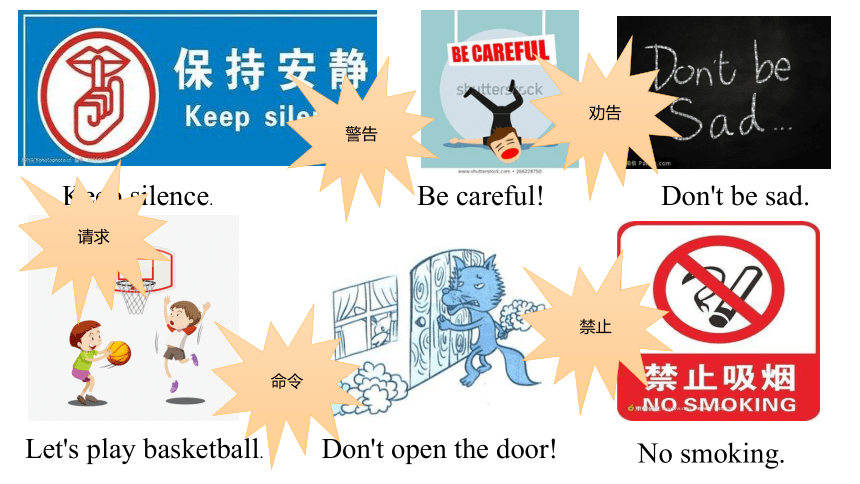
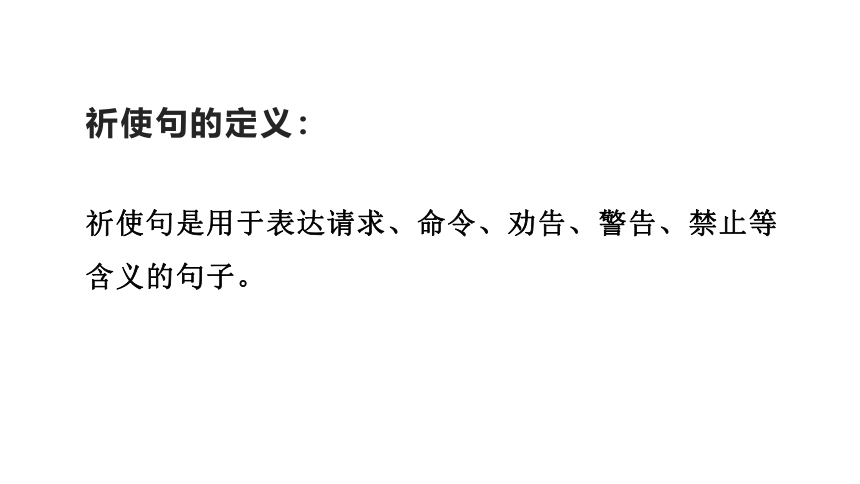



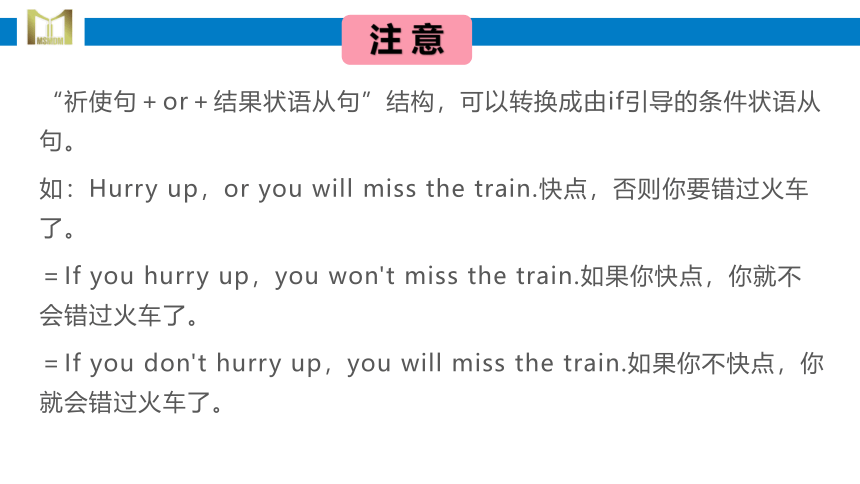
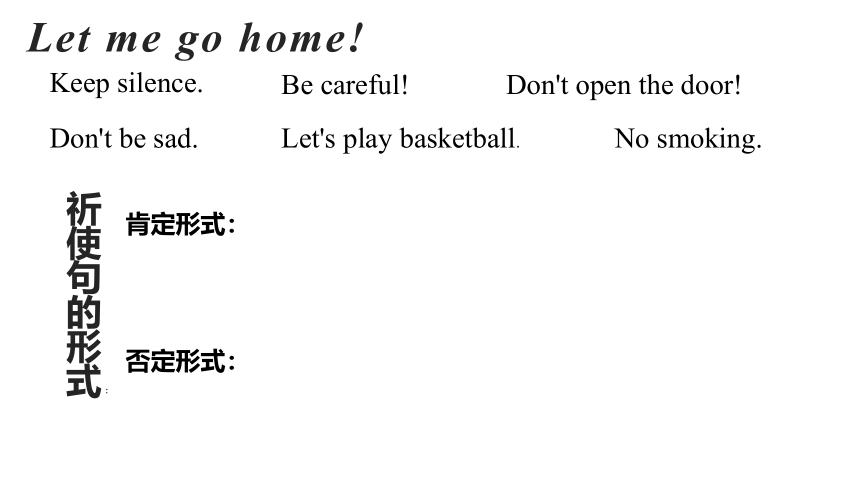
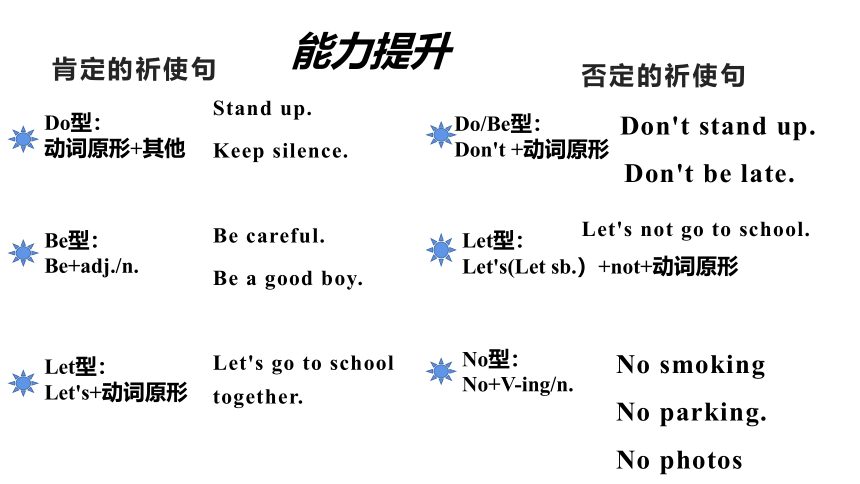
文档简介
(共21张PPT)
初 识 祈 使 句
1、祈使句的定义。
2、祈使句的特点。
3、祈使句的肯定形式和否定形式。
七年级-下册-Unit4 Don't eat in class!
Keep silence.
Be careful!
No smoking.
Let's play basketball.
Don't open the door!
Don't be sad.
请求
命令
劝告
警告
禁止
祈使句的定义:
祈使句是用于表达请求、命令、劝告、警告、禁止等
含义的句子。
祈使句的特点:
silence.
careful!
's play basketball.
动词使用原型,且常用动词原形开头。
其主语为第二人称you,也就是听话人,通常省略。
句末用句号,表示强烈语气时用感叹号。
为使祈使句显得更加委婉有礼貌,可以在开头或结尾处加上please.
Please stand up.
Stand up, please.
up.
Keep
Be
Stand
Brainstorm
Let
肯定形式
PART 1
1
结构 示例
动词原形(+宾语)+其他 Learn wisely and learn well.
Spell it, please.
Be+表语(名词或形容词) Be patient. It takes time.
Be a good learner!
Let sb.+动词原形+其它 Let's play basketball.
否定形式
PART 1
2
结构 示例
Don't+动词(do和be)原形 Don't read word by word.
Don't be late for class !
Let sb.+not+动词原形=Don't let sb.+动词原形 Let him not go there alone.=Don't let him go there alone.
No+名词/v. ing No photos! No smoking!
(常用于公共场合的提示语中)
Never+动词(do和be)原形 Never be late for school!Never give up!
“祈使句+or+结果状语从句”结构,可以转换成由if引导的条件状语从句。
如:Hurry up,or you will miss the train.快点,否则你要错过火车了。
=If you hurry up,you won't miss the train.如果你快点,你就不会错过火车了。
=If you don't hurry up,you will miss the train.如果你不快点,你就会错过火车了。
注 意
Keep silence.
Be careful!
Don't be sad.
Let's play basketball.
Don't open the door!
No smoking.
肯定形式:
否定形式:
Let me go home!
祈使句的形式:
肯定的祈使句
Stand up.
Keep silence.
Be careful.
Be a good boy.
Let's go to school together.
否定的祈使句
Don't stand up.
Don't be late.
No smoking
No parking.
No photos
Be型:Be+adj./n.
Let型:
Let's+动词原形
Do型:
动词原形+其他
Do/Be型:
Don't +动词原形
Let型:
Let's(Let sb.)+not+动词原形
No型:
No+V-ing/n.
Let's not go to school.
能力提升
肯定的祈使句
Stand up.
Keep silence.
Be careful.
Be a good boy.
Let's go to school together.
否定的祈使句
Don't stand up.
Don't be late.
No smoking.
No parking.
No photos.
Summary
Be型:Be+adj./n.
Let型:
Let's+动词原形
Do型:
动词原形+其他
Do/Be型:
Don't +动词原形
Let型:
Let's(Let sb.)+not+动词原形
No型:
No+V-ing/n.
Let's not go to school.
School rules:
不要在课堂上吃东西。
___________ eat in class.
2.上课认真听老师讲课。
_________ ______ the teacher carefully.
3.在图书馆要保持安静。
_________ quiet in the library.
Don't
Listen
to
Be
Obey(遵守) the rules.
Be a good boy.
【课堂实战】
1. (避免)standing against walls and watch where you walk.
2. (驾驶)carefully, please! Look at the road sign. There is a school ahead.
3. Don‘t (制造)a noise!Someone is sleeping.
4. (访问)www.ChinaDaily. if you want to learn more about English news.
Avoid
Drive
make
Visit
祈使句通常是省略了主语的,带有命令、请求、劝告、警告、禁止等语气的句子。
正确使用情态动词 must 和 have to
难点名称:must 和 have to 的区别
七年级-下册-Unit4 Don't eat in class!
情态动词
1.must意思是“必须...”;
肯定形式:must+V原
否定形式:mustn't+V原
疑问形式:Must+主语+V原
eg.1.You must go home now.
2. You mustn't smoke here.
3. Must I finish the homework today
2.have to 意思是“必须”,“不得不”;
否定形式:
have to---don't have to
has to---doesn't have to
had to---didn't have to
否定的 意思是“不必”
eg.
1. It's too late. Tom has to go home.
2. They don't have to finish the work today.
3. He had to leave early yesterday.
4. Did he have to leave early yesterday
3.must 与have to 的区别:
意义上的区别:
must 表示说话人的主观看法,即主观上认为的必要性。
have to 表示客观需要,即 “不得不”。
eg: Her mother is ill. She has to stay at home to look after her mother.(表示客观需要)
I must go now.(我感觉有必要离开)
3.must 与have to 的区别:
② 时态,人称上的区别:
must 没有人称和时态的变化
have to 有人称和时态的变化
eg: She has to look after her mother.
He had to do his homework yesterday.
3.must 与have to 的区别:
③ 否定形式的意义大不相同:
must 的否定mustn't 表示“禁止,不许”。
have to 有的否定don't have to 表示“不必”。
eg: You mustn't arrive late for school.
You don't have to finish the homework now.
4.用must 提问的句子,肯定回答用must,而否定回答则用needn't或者don't have to. 表示“不必”。
eg: --Must I come at four o'clock
--Yes,you must.
--No, you needn't / you don't have to.
Practice
一.请用must 或have to的适当形式填空。
1. I'll ____________ look after my sister at home this Sunday.
2. We__________follow the school rules.
3. I got up late this morning, so I___________take a taxi to school.
4. ---Must I get to the station before five o'clock
---Yes, you__________.
---No, you________________
have to
must
had to
must
don't have to
Thank you for listening!
初 识 祈 使 句
1、祈使句的定义。
2、祈使句的特点。
3、祈使句的肯定形式和否定形式。
七年级-下册-Unit4 Don't eat in class!
Keep silence.
Be careful!
No smoking.
Let's play basketball.
Don't open the door!
Don't be sad.
请求
命令
劝告
警告
禁止
祈使句的定义:
祈使句是用于表达请求、命令、劝告、警告、禁止等
含义的句子。
祈使句的特点:
silence.
careful!
's play basketball.
动词使用原型,且常用动词原形开头。
其主语为第二人称you,也就是听话人,通常省略。
句末用句号,表示强烈语气时用感叹号。
为使祈使句显得更加委婉有礼貌,可以在开头或结尾处加上please.
Please stand up.
Stand up, please.
up.
Keep
Be
Stand
Brainstorm
Let
肯定形式
PART 1
1
结构 示例
动词原形(+宾语)+其他 Learn wisely and learn well.
Spell it, please.
Be+表语(名词或形容词) Be patient. It takes time.
Be a good learner!
Let sb.+动词原形+其它 Let's play basketball.
否定形式
PART 1
2
结构 示例
Don't+动词(do和be)原形 Don't read word by word.
Don't be late for class !
Let sb.+not+动词原形=Don't let sb.+动词原形 Let him not go there alone.=Don't let him go there alone.
No+名词/v. ing No photos! No smoking!
(常用于公共场合的提示语中)
Never+动词(do和be)原形 Never be late for school!Never give up!
“祈使句+or+结果状语从句”结构,可以转换成由if引导的条件状语从句。
如:Hurry up,or you will miss the train.快点,否则你要错过火车了。
=If you hurry up,you won't miss the train.如果你快点,你就不会错过火车了。
=If you don't hurry up,you will miss the train.如果你不快点,你就会错过火车了。
注 意
Keep silence.
Be careful!
Don't be sad.
Let's play basketball.
Don't open the door!
No smoking.
肯定形式:
否定形式:
Let me go home!
祈使句的形式:
肯定的祈使句
Stand up.
Keep silence.
Be careful.
Be a good boy.
Let's go to school together.
否定的祈使句
Don't stand up.
Don't be late.
No smoking
No parking.
No photos
Be型:Be+adj./n.
Let型:
Let's+动词原形
Do型:
动词原形+其他
Do/Be型:
Don't +动词原形
Let型:
Let's(Let sb.)+not+动词原形
No型:
No+V-ing/n.
Let's not go to school.
能力提升
肯定的祈使句
Stand up.
Keep silence.
Be careful.
Be a good boy.
Let's go to school together.
否定的祈使句
Don't stand up.
Don't be late.
No smoking.
No parking.
No photos.
Summary
Be型:Be+adj./n.
Let型:
Let's+动词原形
Do型:
动词原形+其他
Do/Be型:
Don't +动词原形
Let型:
Let's(Let sb.)+not+动词原形
No型:
No+V-ing/n.
Let's not go to school.
School rules:
不要在课堂上吃东西。
___________ eat in class.
2.上课认真听老师讲课。
_________ ______ the teacher carefully.
3.在图书馆要保持安静。
_________ quiet in the library.
Don't
Listen
to
Be
Obey(遵守) the rules.
Be a good boy.
【课堂实战】
1. (避免)standing against walls and watch where you walk.
2. (驾驶)carefully, please! Look at the road sign. There is a school ahead.
3. Don‘t (制造)a noise!Someone is sleeping.
4. (访问)www.ChinaDaily. if you want to learn more about English news.
Avoid
Drive
make
Visit
祈使句通常是省略了主语的,带有命令、请求、劝告、警告、禁止等语气的句子。
正确使用情态动词 must 和 have to
难点名称:must 和 have to 的区别
七年级-下册-Unit4 Don't eat in class!
情态动词
1.must意思是“必须...”;
肯定形式:must+V原
否定形式:mustn't+V原
疑问形式:Must+主语+V原
eg.1.You must go home now.
2. You mustn't smoke here.
3. Must I finish the homework today
2.have to 意思是“必须”,“不得不”;
否定形式:
have to---don't have to
has to---doesn't have to
had to---didn't have to
否定的 意思是“不必”
eg.
1. It's too late. Tom has to go home.
2. They don't have to finish the work today.
3. He had to leave early yesterday.
4. Did he have to leave early yesterday
3.must 与have to 的区别:
意义上的区别:
must 表示说话人的主观看法,即主观上认为的必要性。
have to 表示客观需要,即 “不得不”。
eg: Her mother is ill. She has to stay at home to look after her mother.(表示客观需要)
I must go now.(我感觉有必要离开)
3.must 与have to 的区别:
② 时态,人称上的区别:
must 没有人称和时态的变化
have to 有人称和时态的变化
eg: She has to look after her mother.
He had to do his homework yesterday.
3.must 与have to 的区别:
③ 否定形式的意义大不相同:
must 的否定mustn't 表示“禁止,不许”。
have to 有的否定don't have to 表示“不必”。
eg: You mustn't arrive late for school.
You don't have to finish the homework now.
4.用must 提问的句子,肯定回答用must,而否定回答则用needn't或者don't have to. 表示“不必”。
eg: --Must I come at four o'clock
--Yes,you must.
--No, you needn't / you don't have to.
Practice
一.请用must 或have to的适当形式填空。
1. I'll ____________ look after my sister at home this Sunday.
2. We__________follow the school rules.
3. I got up late this morning, so I___________take a taxi to school.
4. ---Must I get to the station before five o'clock
---Yes, you__________.
---No, you________________
have to
must
had to
must
don't have to
Thank you for listening!
同课章节目录
- Unit 1 Can you play the guitar?
- Section A
- Section B
- Unit 2 What time do you go to school?
- Section A
- Section B
- Unit 3 How do you get to school?
- Section A
- Section B
- Unit 4 Don't eat in class.
- Section A
- Section B
- Unit 5 Why do you like pandas?
- Section A
- Section B
- Unit 6 I'm watching TV.
- Section A
- Section B
- Review of Units 1-6
- Unit 7 It's raining!
- Section A
- Section B
- Unit 8 Is there a post office near here?
- Section A
- Section B
- Unit 9 What does he look like?
- Section A
- Section B
- Unit 10 I'd like some noodles.
- Section A
- Section B
- Unit 11 How was your school trip?
- Section A
- Section B
- Unit 12 What did you do last weekend?
- Section A
- Section B
